The Ultimate Guide to Procurement Risk Assessment


Procurement is the backbone of a successful business, but it’s a complex process rife with a lot of potential risks.
From supplier failures to market volatility and regulatory changes, these issues can cause supply chain disruptions, financial losses, and damage to your organization’s reputation.
If you’re struggling to identify, analyze, and proactively manage these risks, this comprehensive guide is for you.
We’ll explore the fundamentals of procurement risk assessment, providing a step-by-step roadmap to navigate the process effectively.
By the end of this guide, you’ll gain a deep understanding of what procurement risk assessment is, its importance for your business, and strategies to assess risks within your organization.
Let’s begin.
First, let’s clear up the concept of procurement risk assessment.
In essence, this is a critical component of procurement risk management, which is the broader practice of assessing risk, creating risk management strategies, and mitigating potential threats to procurement and supply chain activities.
Procurement risk assessment, specifically, is defined in the image below.
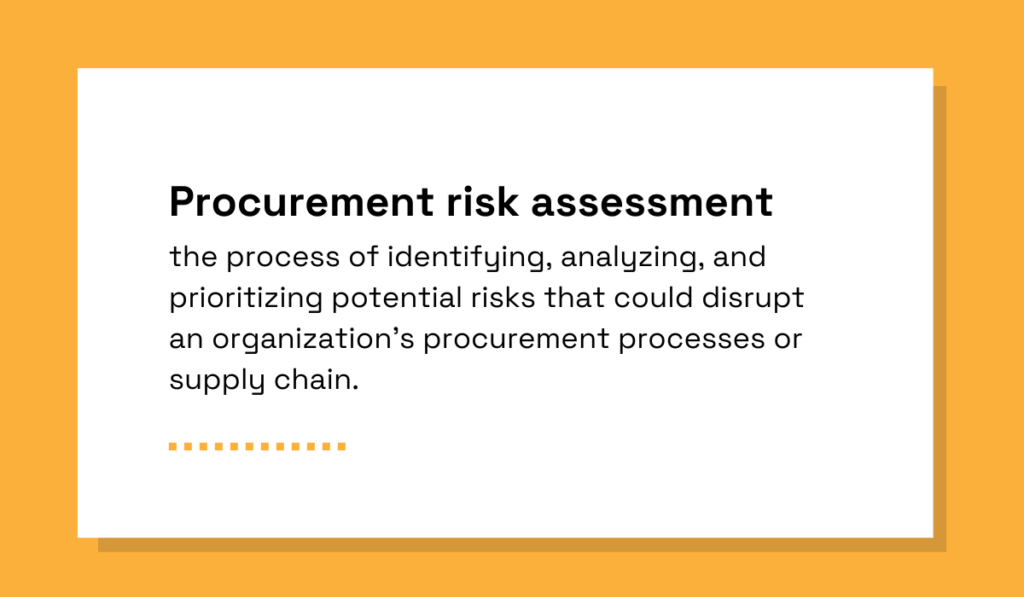
Source: Veridion
Let’s unpack this definition a bit further.
The most important aspect of risk assessment is the initial identification of potential risks.
This is crucial, as it’s impossible to protect your business from threats you don’t even know exist.
By proactively recognizing potential issues and asking questions like the ones shown below, you create the foundation for effective mitigation strategies.
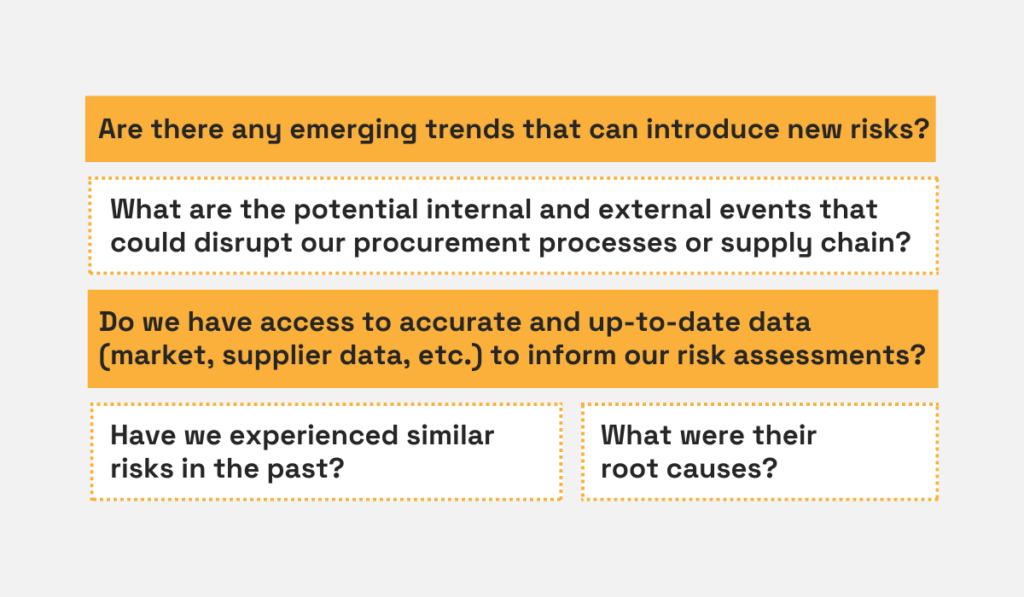
Source: Veridion
These are just a few questions that give you a glimpse at a complex process that involves analyzing both emerging threats and historical data.
It also involves assessing whether your organization has sufficient info and the right tools and processes to accurately analyze risks.
Procurement risk assessment encompasses a wide range of factors, typically categorized as micro and macro risks.
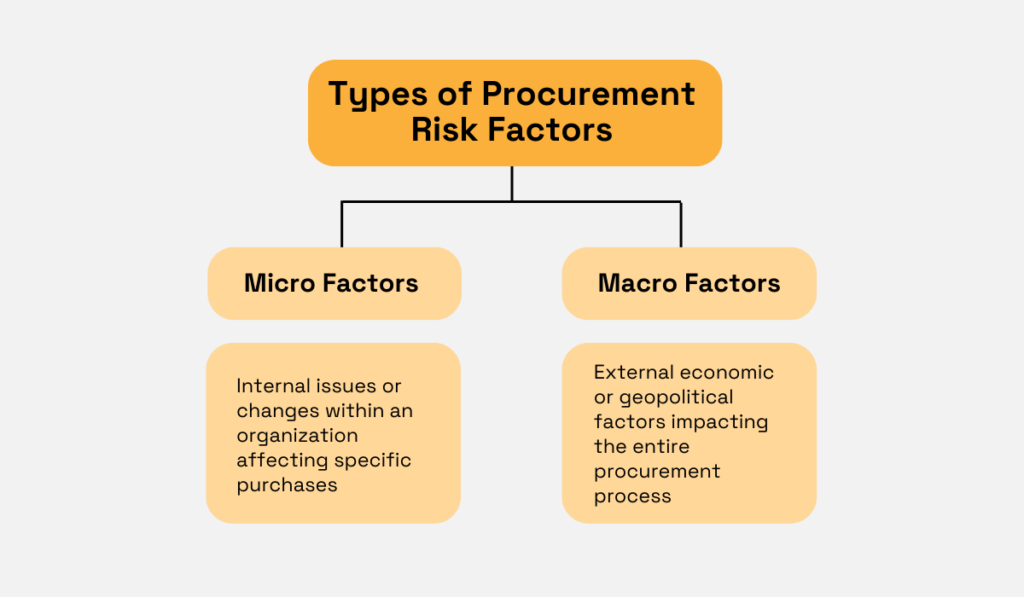
Source: Veridion
Micro factors are those within your organization’s control, such as supplier performance, contractual terms, and the efficiency of your internal processes.
Macro factors, on the other hand, are external forces, like economic conditions, a country’s geopolitical situation, regulatory changes, and even natural disasters.
While the full risk assessment process includes analyzing the likelihood and impact of each identified risk and prioritizing them accordingly, we’ll cover those steps in greater detail in a separate section.
For now, just remember that risk assessment is a foundational element of effective procurement risk management.
It helps you develop a clear understanding of potential threats, enabling you to proactively safeguard your supply chain and minimize disruptions.
Now that you have a better understanding of what procurement risk assessment is, you may wonder how much time and resources you should allocate to it.
After all, if you have a clear and organized procurement process in place, it may seem that risk assessment is not a top priority.
Well, in the following sections, we aim to convince you that this is not just an optional practice, but an essential aspect of efficient and effective procurement.
Let’s explore four compelling reasons why.
First off, let’s explore how risk assessment helps keep your procurement engine running smoothly.
Supply chain disruptions are a constant threat, with potentially devastating consequences for organizations.
A survey of 400 senior supply chain and procurement executives reveals these consequences can range from damage to reputation and increased costs to significant delays.
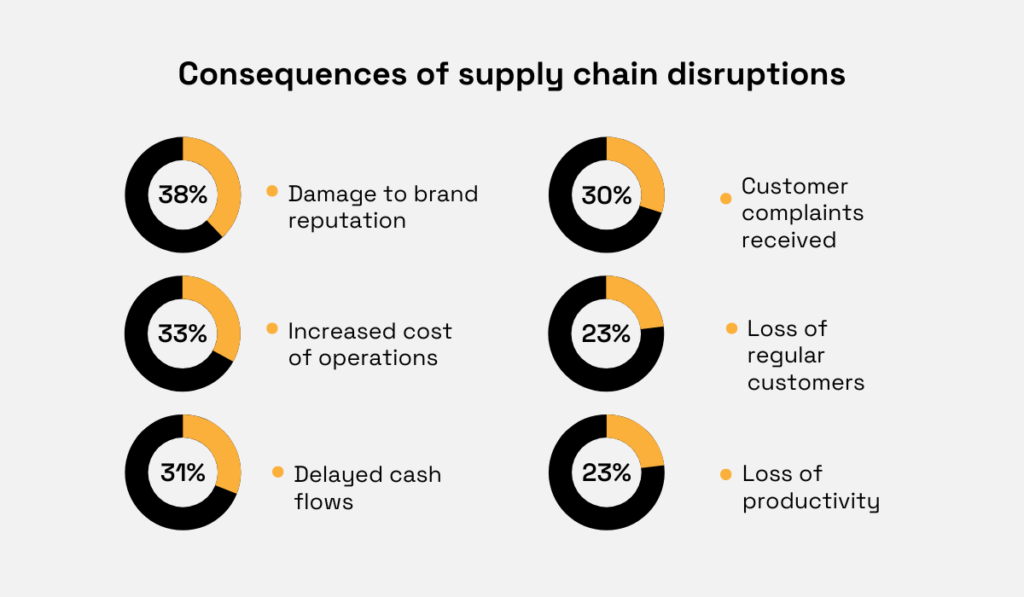
Illustration: Veridion / Data: The Economist
While less frequently reported, disruptions can ultimately affect customers, leading to more complaints due to product shortages or delayed shipments.
This can, in turn, lead to the loss of regular customers who become frustrated with unreliable service.
These disruptions also come with a hefty price tag, with Interos data revealing the numbers.
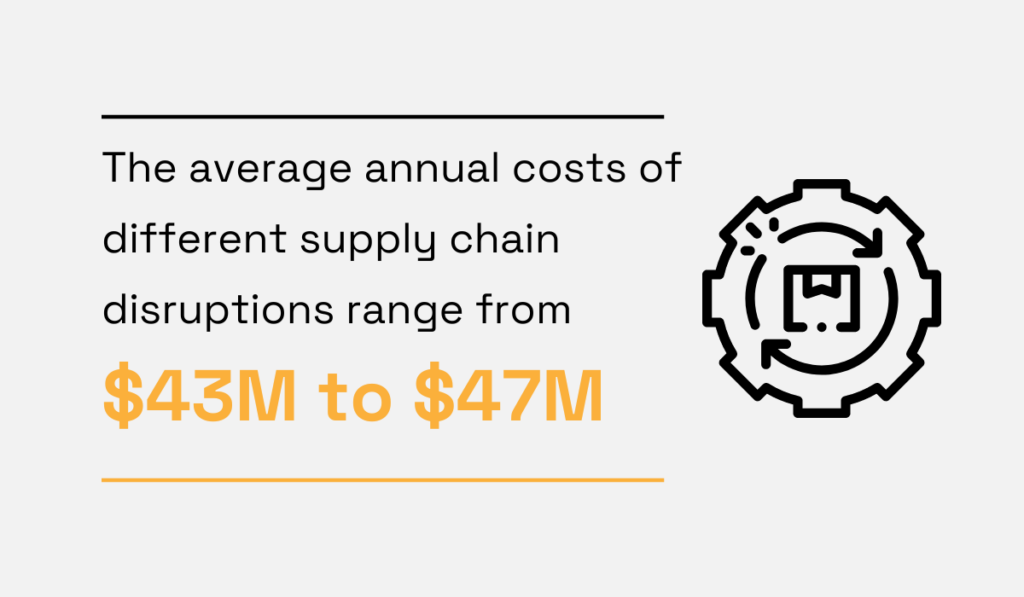
Illustration: Veridion / Data: Interos
These costs can arise from expedited shipping, rush orders to replace faulty or delayed goods, and the need to find alternative suppliers.
Additional expenses might include overtime for staff working to resolve problems and potential penalties for failing to meet contractual obligations.
Risk assessment helps reduce or even avoid these disruptions.
By thoroughly understanding and assessing some of the common procurement risks, your team can proactively develop strategies to avoid them.
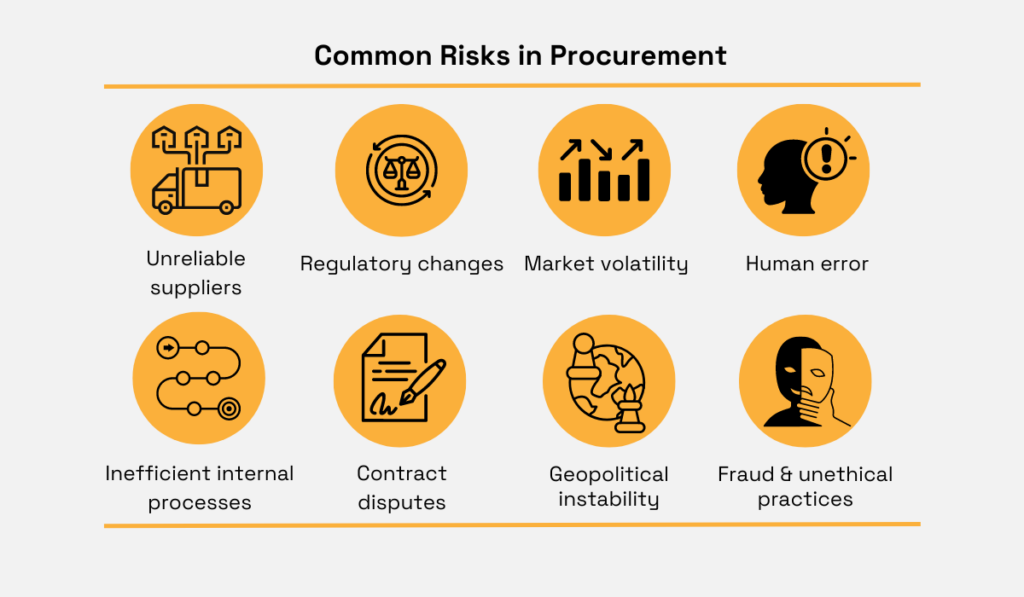
Source: Veridion
This might involve implementing measures like diversifying your supplier base to reduce reliance on a single source or investing in backup inventory for critical materials.
It could also mean improving internal processes to reduce human error or implementing safeguards against cyberattacks.
In each case, risk mitigation focuses on ensuring smooth operations and minimizing negative impacts on the supply chain.
Next, let’s explore how a thorough risk assessment can guide your procurement strategy, specifically when it comes to choosing the right procurement method.
As you know, there’s no one-size-fits-all approach in procurement.
The most effective method for your organization will depend on a variety of factors, with the risks you’ve identified being a major consideration.
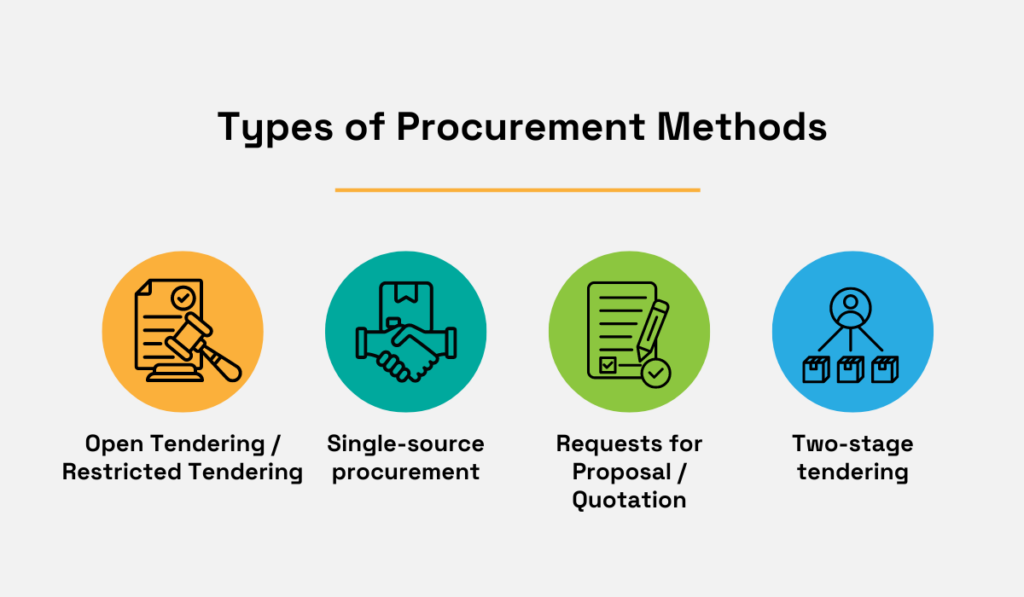
Source: Veridion
By identifying what could go wrong, you can tailor your procurement approach to mitigate these risks effectively.
This isn’t about finding a one-to-one match between risk and procurement methods, but rather about using risk assessment to make informed, strategic decisions that align with your business goals.
It’s important to keep in mind that choosing a procurement method based on risk assessments involves weighing several factors, outlined in the image below.
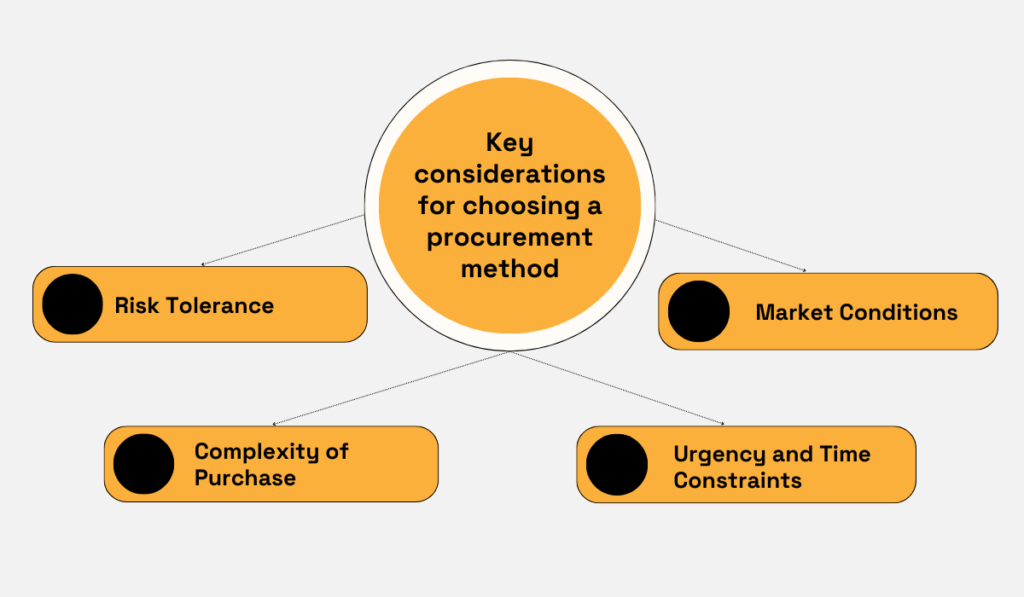
Source: Veridion
For example, sometimes, even with numerous risks identified, your organization’s high tolerance for risk might allow you to pursue more aggressive procurement strategies that offer higher returns.
Conversely, a low-risk tolerance might necessitate a more conservative approach.
The complexity of the purchase, the associated risks, time constraints, and market conditions all play critical roles in shaping your procurement strategy.
These factors must be carefully balanced to choose the most suitable method that manages risks but also leverages potential market opportunities.
Here’s a table that illustrates how specific risk assessments might influence the choice of a procurement method and the rationale behind these decisions.
| Assessed Risk | Procurement Method | Reasoning |
|---|---|---|
| Potential price volatility for critical raw materials | Long-term contracts or fixed-price agreements | Locks in prices and provides stability against fluctuations |
| Urgent need for essential components with limited supplier options | Spot purchase or direct sourcing | Allows for flexibility to address specific needs and evaluation of supplier capabilities |
| Supplier with a history of quality issues | Open tender procurement | Prioritizes speed and accessibility over potentially achieving the lowest price |
Keep in mind—this table is a simplified overview.
In real-world scenarios, you might find that certain procurement methods are adaptable and can be modified to address multiple risks.
Ultimately, your risk assessment can guide you toward the procurement method that best aligns with your organization’s unique risk profile and operational objectives.
Next up, let’s tackle a big reason why you should consider risk assessment, which has everything to do with staying on the right side of the law.
The amount of laws and regulations affecting procurement is extensive, with some of the following among them:
Risk assessment helps you navigate this complex regulatory maze by allowing you to identify potential areas of non-compliance within your procurement practices and supplier relationships.
By uncovering these risks early on, you can take steps to proactively mitigate them, ensuring adherence to legal requirements and safeguarding your organization from costly fines, legal action, or reputational damage.
Procurement mishaps related to compliance can happen at any time, especially when dealing with the added complexity of city and state-specific procurement regulations.
Take the example of the City Water Bureau in the City of Portland shown below.
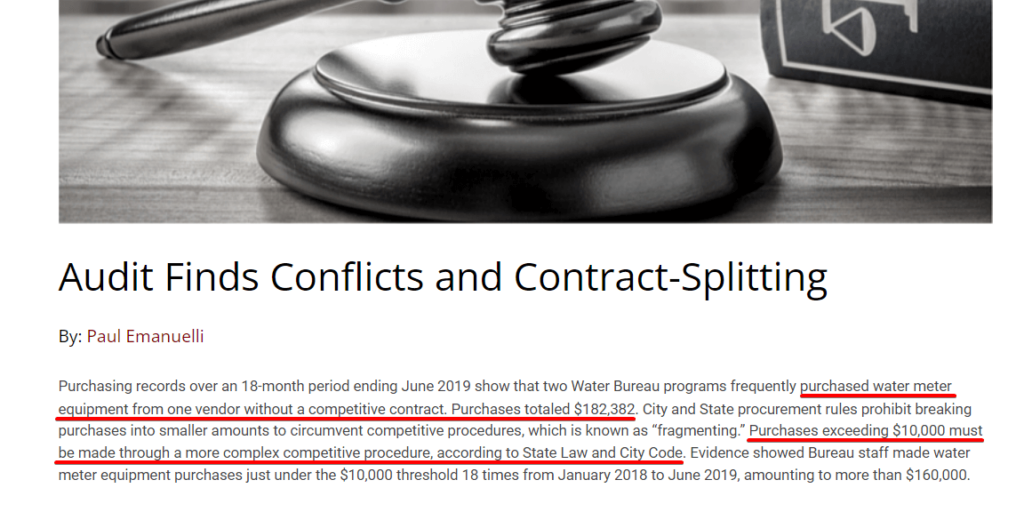
Source: Procurement Office
In this case, the Bureau failed to follow competitive procedures for a large purchase, violating local procurement regulations.
To make matters worse, there were ethical violations involved with the supervisor procuring from a company that employed his manager’s spouse, who received commissions on the sales.
A thorough risk assessment process helps prevent such compliance issues by pinpointing these common procurement regulatory risks early on.
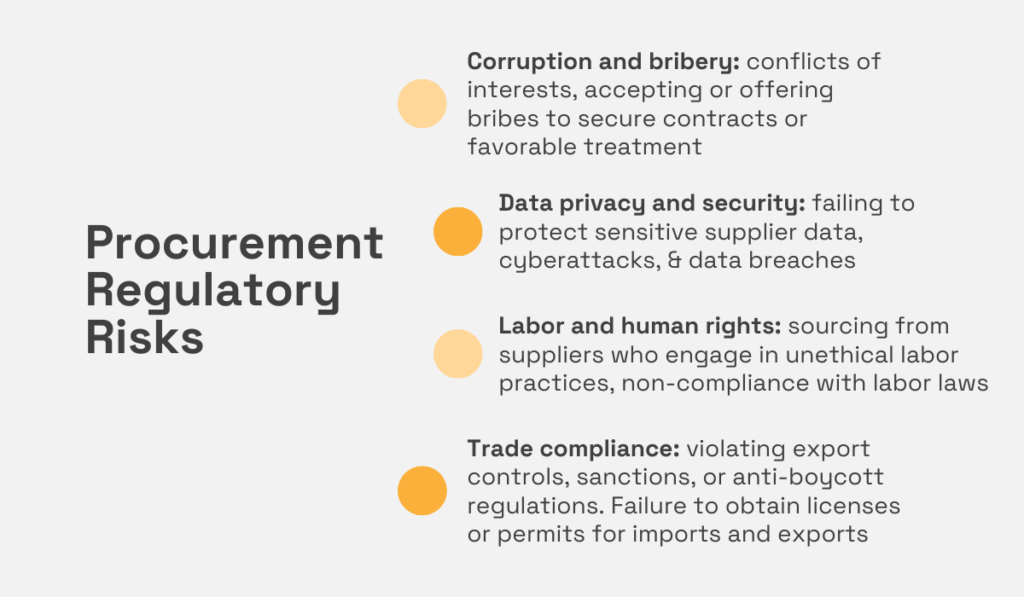
Source: Veridion
This is especially important because, as regulations continue to evolve, staying compliant requires consistent monitoring and adaptation.
A thorough and unbiased risk assessment process is essential for keeping up with changes, avoiding legal pitfalls, and ensuring that procurement activities are both ethical and compliant.
Finally, let’s not underestimate the power of risk assessment when it comes to building trust and confidence among your organization’s stakeholders.
Let’s start with investors, who have a vested financial stake in your organization.
They’re naturally concerned about any risks that could negatively impact profitability or hinder the company’s growth trajectory.
Lauri Vihonen, Managing Director at Leader’s Beacon Group, a procurement, information management, and project management consulting and training company, shared the following on this topic.
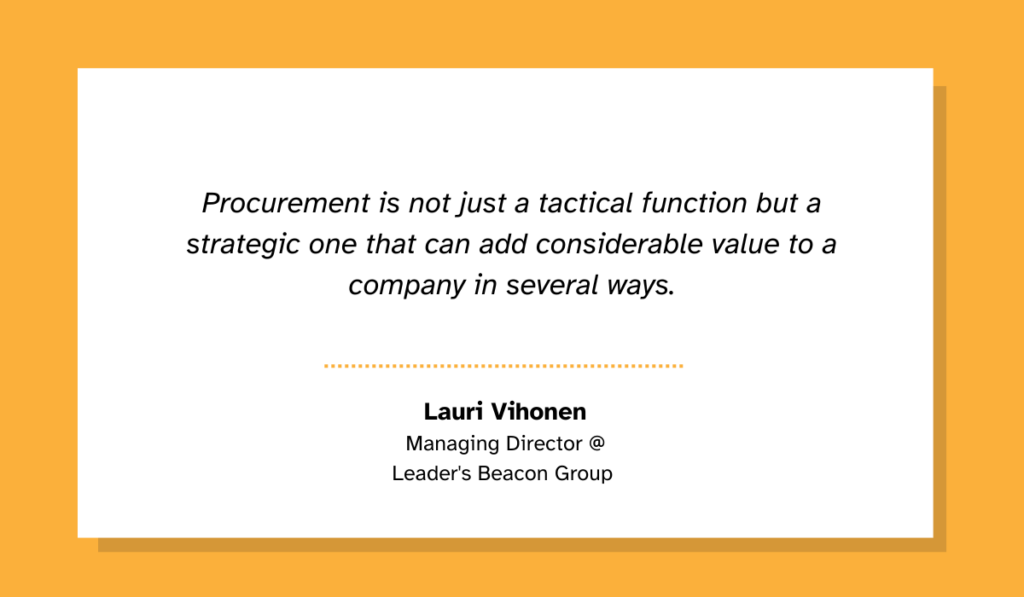
Illustration: Veridion / Data: Finnish VC Association
As the Finnish VC Association paraphrases, Vihonen believes that VCs should pay close attention to procurement because it directly impacts a company’s profitability and scalability—two critical factors determining the potential return on investment.
Procurement risks like supplier issues, along with other threats, such as market volatility or regulatory changes, can also significantly impact your customers.
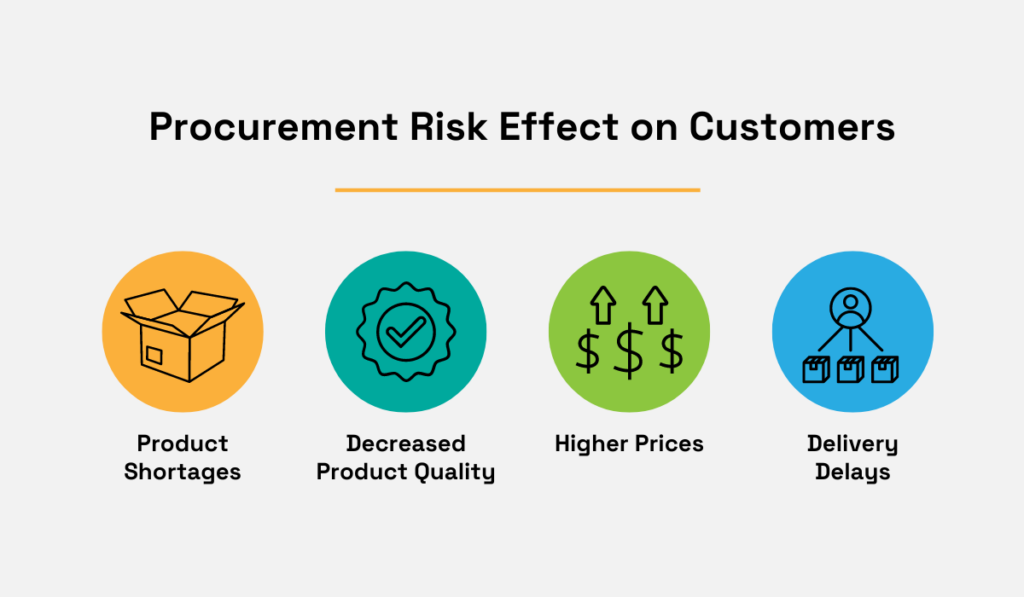
Source: Veridion
If left unchecked, these risks can cause supply chain delays, leading to product shortages and delivery delays that leave customers frustrated and dissatisfied.
Conversely, effective risk assessment can help maintain product quality by ensuring reliable sourcing of components and raw materials.
It can also contribute to cost savings by identifying opportunities for optimization, which can be passed on to customers in the form of lower prices.
As you can see, procurement risk assessment isn’t just an internal concern.
This process plays a crucial role in building trust and maintaining strong relationships with various stakeholders who rely on your organization’s ability to manage risk and deliver on its promises.
Now that we’ve discussed the many reasons to conduct a risk assessment, let’s explore how to effectively perform one.
Assessing risks in procurement can be complex, primarily due to the varied nature of risks and the multiple layers of procurement activities.
However, the entire procurement risk assessment process is typically divided into several steps shown below.
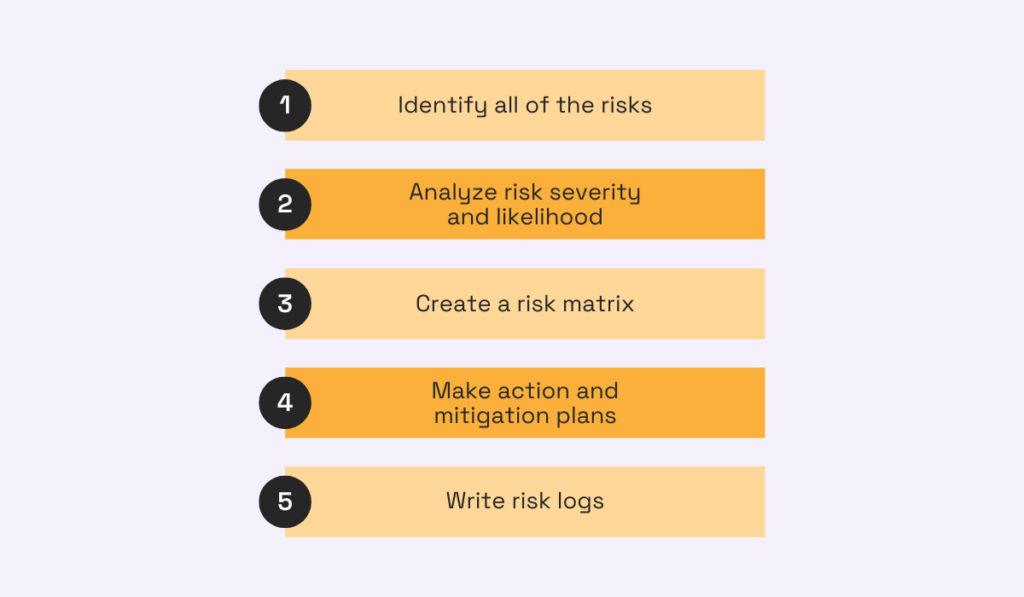
Source: Veridion
The first step is, of course, identifying risks.
This involves a thorough examination of all stages of the procurement process to pinpoint potential vulnerabilities—whether they stem from supplier reliability, market fluctuations, regulatory changes, or internal operational weaknesses.
Once risks are identified, they should be analyzed.
Here, it’s critical to determine which risks need the most attention and resources by evaluating the severity and likelihood of each risk.
Severity refers to the potential impact of the risk, while likelihood assesses how probable it is that the risk will occur—where both of these are often categorized as high, medium, or low.
Next, a risk matrix is created based on this analysis, putting risk severity on one axis and likelihood on the other.
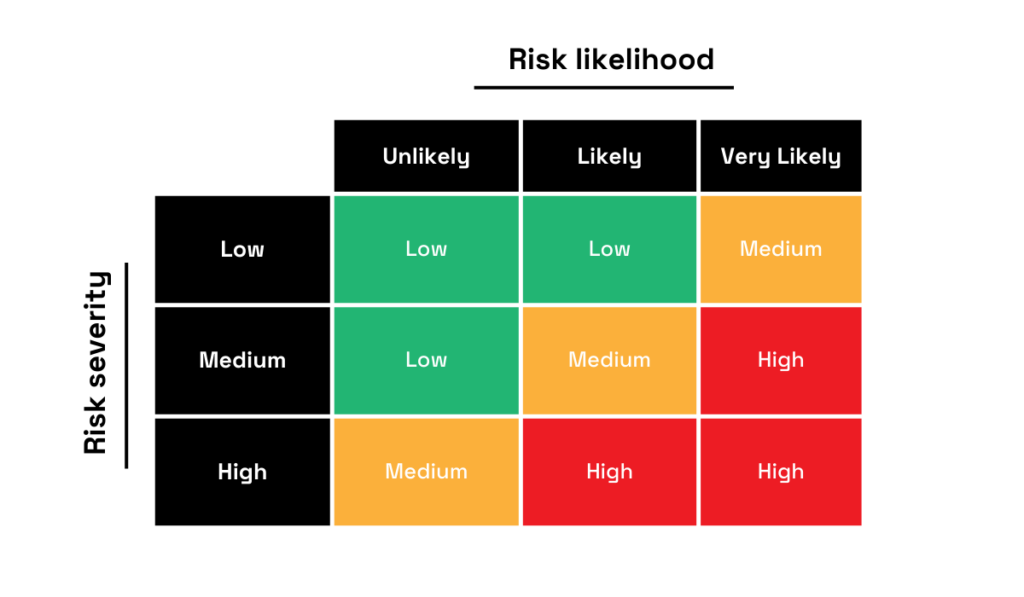
Source: Veridion
This matrix usually varies in complexity, but a simple 3×3 format can effectively illustrate the concept.
By combining the impact and probability of each risk, this matrix helps prioritize them.
For example, risks that are both highly likely to occur and have severe consequences are classified as high priority, and vice versa.
After identifying the priority risks, you can start thinking about action and mitigation plans.
These plans can take various forms like the following:
Finally, it’s essential to document your risk assessment in a comprehensive risk log or register.
This document serves as a centralized repository for all identified risks, their assessment, and the corresponding mitigation strategies, including elements like the ones shown below.
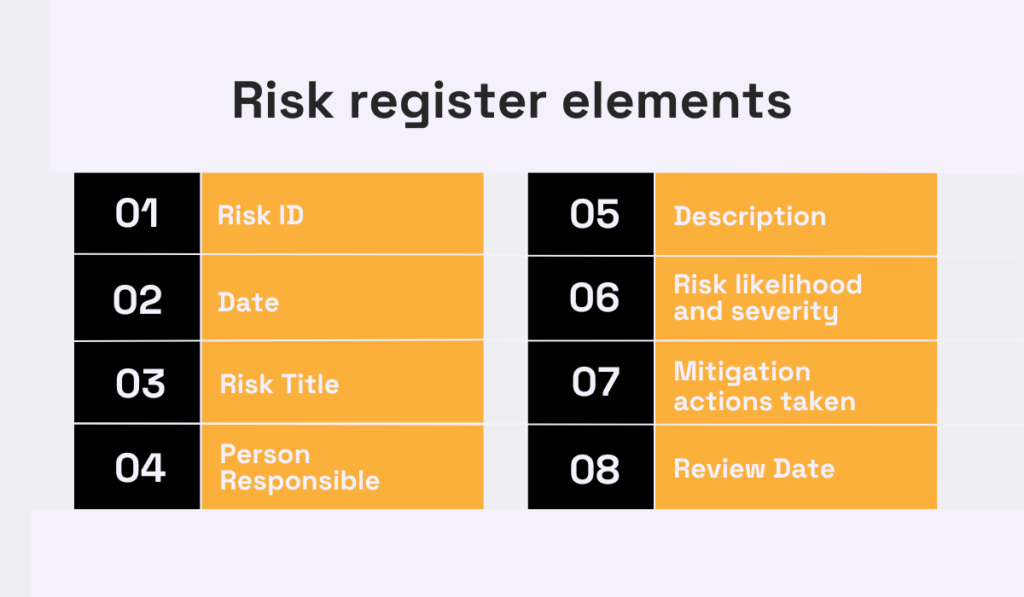
Source: Veridion
This organized documentation not only facilitates communication across teams but also provides a historical record of your risk management efforts, enabling continuous improvement over time.
By following these steps and conducting a comprehensive risk assessment, you can build a resilient procurement process that safeguards your organization from unexpected disruptions and keeps your operations running smoothly.
We’ve covered a lot of ground in this guide on procurement risk assessment.
You should now have a complete overview of this process and its various benefits, from minimizing disruptions and ensuring regulatory compliance to increasing stakeholder trust.
Most importantly, you should have a solid understanding of the steps to assess and mitigate procurement-related risks in your organization.
We hope that this guide has empowered you to approach the whole risk assessment process with more confidence and clarity.
As a final note, it’s important to understand that effective risk assessment is a journey.
So stay vigilant and adaptable and you’ll stay ahead of emerging threats.